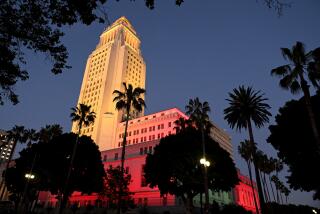How Does City Work? Mayor’s Shadows Know
- Share via
Miriam Alcantar’s geography project could have been a real sleeper: figure out how city government works.
But the Jefferson High School freshman and two classmates approached their task in a decidedly novel way: They called Los Angeles Mayor Antonio Villaraigosa’s office and asked if they could shadow the city’s most famous public citizen.
On Wednesday afternoon, Miriam, Brenda Serrato and Gabrielle Hubbard got their wish: The three South Los Angeles students cruised around the city with Villaraigosa in his gleaming, black sport utility vehicle, peppering him with questions as if they were part of the City Hall press corps.
Why do you want to run the Los Angeles Unified School District schools?
Do you believe the City Charter needs to be amended in any way?
How do you feel about being the first Latino mayor since 1872?
Villaraigosa responded to each question patiently, offering answers that were pleasant and sometimes satisfying. He was in his element, holding court at 50 mph with his favorite audience: schoolchildren.
But then, the ride-along was a no-brainer for a mayor who knows how to seize an opportunity to promote his ideas -- and himself.
“Look at me,” Villaraigosa told the girls as they hopped into the SUV after a news conference in the Crenshaw district to announce a new summer jobs program. “I grew up in the same kinds of neighborhoods as you did. And I made it.”
The idea to study city government -- and shadow Villaraigosa -- grew out of Jefferson High’s Film and Theatre Arts Academy, which emphasizes real-world education outside the bounds of the traditional classroom.
Teachers wanted to expand the horizons of students, some of whom had never heard of the Hollywood Walk of Fame or could not locate Venice on a Los Angeles map.
Above all, the teachers wanted to press their students to explore beyond their own neighborhoods to better understand the social and cultural geography of Los Angeles.
“The whole purpose was to make them agents of their own learning, to get to know the city in ways that more economically privileged kids take for granted,” said academy coordinator Steve Bachrach.
Students chose their topics of inquiry. One group focused on the history of the entertainment industry in Los Angeles. Another delved into tourism and its effects on the economy. Other students examined ethnic groups in the city, including Japanese Americans and Croatians.
Miriam, Brenda and Gabrielle chose city government, focusing their inquiry on money, jobs and schools.
They visited City Hall a few weeks ago and met Villaraigosa in a chance encounter. What they really needed, however, was face time on camera with the mayor for a documentary they were planning. And so, with a little help from Bachrach, they found a phone number for Villaraigosa’s South Los Angeles field office.
Miriam reached the mayor’s area director, Brenda Anderson, and asked if she and her two friends could shadow Villaraigosa. The girls followed up the next day with a lengthy e-mail.
Anderson passed the query to the mayor’s schedulers, who receive 3,000 scheduling requests a month.
“I was real impressed,” Anderson said of the girls’ tenacity. “They were responsible. I told them that I had to take them seriously.”
Two weeks after putting in their request, Miriam, Brenda and Gabrielle were sitting in Villaraigosa’s SUV. And they came prepared.
Miriam was recording the event with a video camera -- footage for the documentary they plan to show their classmates and parents next month.
Their afternoon started at the Los Angeles Urban League’s work-source center in the Crenshaw district, where Villaraigosa touted a new summer youth employment program that is expected to create 5,000 jobs.
As Villaraigosa and half a dozen other speakers took the microphone under a blazing sun, Miriam yawned and Brenda fanned her face with a folded piece of paper.
Then the afternoon got rolling.
The students followed Villaraigosa into his SUV for a 20-minute trip to Roosevelt High School for the opening of a new teen court sponsored by the Los Angeles Superior Court.
Inside the car, the girls got their chance to film Villaraigosa up close and ask him questions from a list they had prepared.
What were his main duties as mayor? they asked.
Villaraigosa responded: to keep the city safe and to work with the City Council.
What were three major things that he would change about city government?
He said he wanted to improve the schools, ease traffic and hire more police.
The girls, a little nonplused by their encounter with Villaraigosa, said they were nonetheless pleased with the outcome, even if they only got him alone for less than 30 minutes.
“It was weird and surprising,” Miriam said. “You don’t get to ride with the mayor every day. I never imagined that he would be patient.”
Gabrielle said she came away with the impression that Villaraigosa “likes kids.”
“He cares about them getting a good education,” she said.
And she also came away with a new realization: being mayor is a busy job.
“I don’t think I can handle that much responsibility,” she said.
More to Read
Sign up for Essential California
The most important California stories and recommendations in your inbox every morning.
You may occasionally receive promotional content from the Los Angeles Times.













